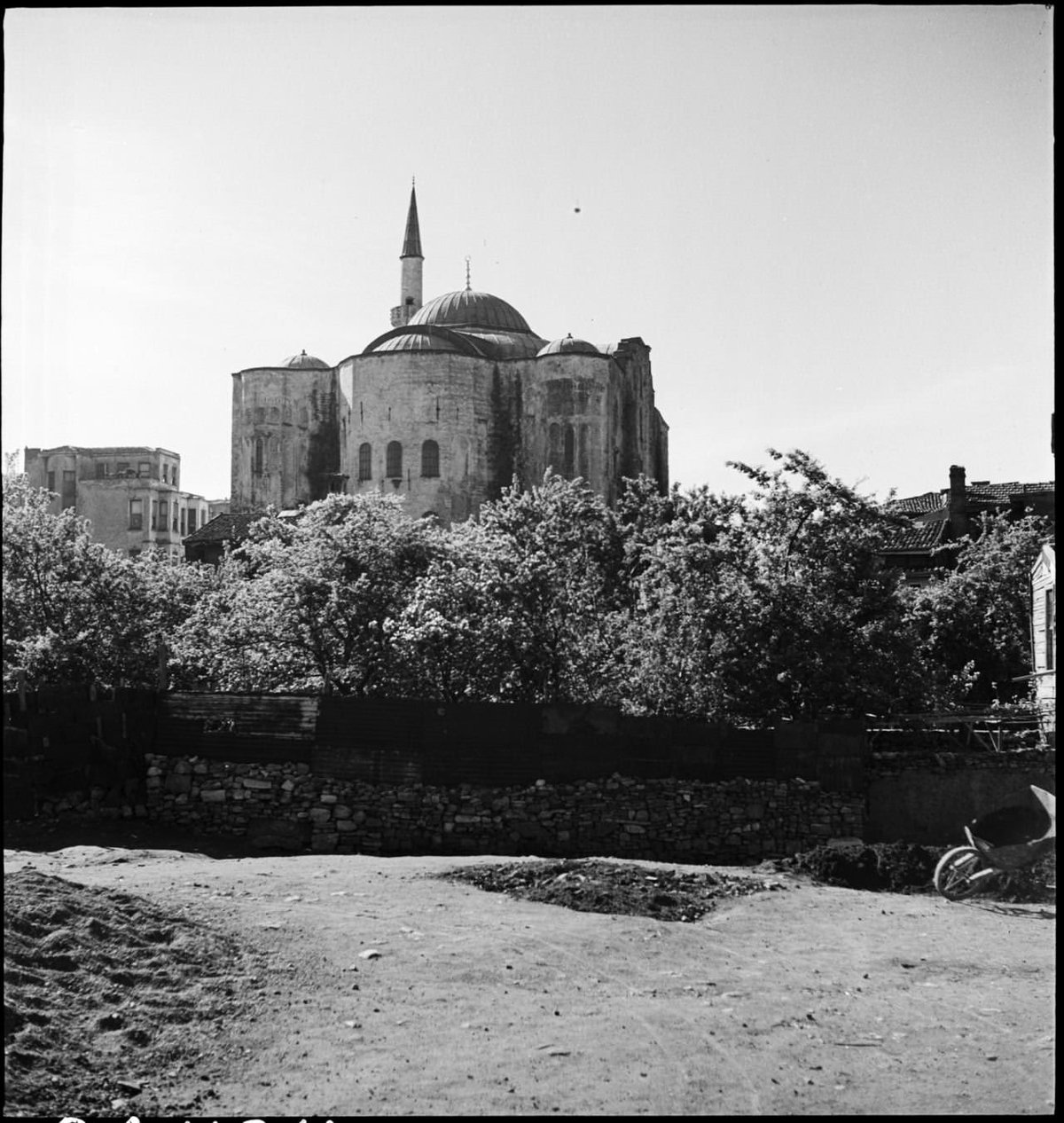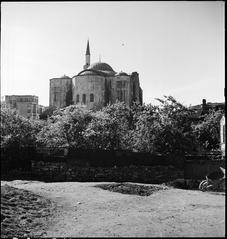
Gül Mosque Istanbul: Visiting Hours, Tickets, and Historical Information
Date: 14/06/2025
Introduction
Nestled in the historic Fatih district, Gül Mosque (Gül Camii) is a stunning testament to Istanbul’s layered religious and architectural heritage. Once a significant Byzantine church—possibly dedicated to Saint Theodosia or Christ Euergetes—it later became a mosque after the Ottoman conquest. The structure’s unique blend of Byzantine and Ottoman features, its rich historical context, and its tranquil atmosphere make Gül Mosque a must-visit for those interested in Istanbul’s historical sites. This guide provides detailed information about visiting hours, tickets, architectural highlights, accessibility, and practical travel tips for a rewarding experience at Gül Mosque (everything.explained.today; The Byzantine Legacy; Spotting History; Lonely Planet).
Contents
- Introduction
- Location and Setting
- Historical Background and Architectural Evolution
- Architectural Features
- Visiting Information (Hours, Tickets, Etiquette)
- Accessibility and Facilities
- Nearby Attractions and Photography Tips
- Practical Visitor Tips
- Frequently Asked Questions (FAQ)
- Conclusion
Location and Setting
Gül Mosque is perched on a hill in the Ayakapı neighborhood of Fatih, offering commanding views over the Golden Horn. Its elevated position not only makes it a prominent landmark but also situates it near other major historical attractions in Istanbul (Wikipedia; The Byzantine Legacy). The mosque is easily accessible via public transport, with tram and bus lines stopping nearby.
Historical Background and Architectural Evolution
Originally constructed as a Byzantine church in the 11th or 12th century, Gül Mosque’s precise dedication remains debated among historians. It may have been the Church of St. Theodosia or the Monastery of Christ Euergetes (The Byzantine Legacy; Wikipedia). The cross-in-square plan, high vaulted basement, and triple apses are hallmarks of Byzantine architecture.
After the Ottoman conquest in 1453, the church was converted into a mosque, with a minaret and mihrab added and significant Ottoman restorations over the centuries. This layered history reflects the blend of Christian and Islamic influences that define much of Istanbul’s built environment (everything.explained.today; Spotting History).
Architectural Features
Exterior
Gül Mosque’s exterior combines red brick and stone masonry, typical of Byzantine construction, and is supported by a high, vaulted substructure. The single elegant minaret, added in the 16th century, reflects early Ottoman style (The Byzantine Legacy; Istanbul Clues; Wikipedia).
Entrance
Visitors enter through a large, wooden door with traditional ironwork, enhancing the mosque’s historic charm (Istanbul Clues).
Interior
The mosque follows a classic Byzantine cross-in-square plan, featuring a central dome, four smaller domes at the corners, and a triple apse at the eastern end. Ottoman additions include a mihrab, minbar, and painted plasterwork, with some decorative motifs reflecting Istanbul’s diverse cultural history. Remnants of original Byzantine frescoes may still be found beneath later plaster (The Byzantine Legacy; Spotting History).
Substructure
A spacious vaulted basement lies beneath the mosque, likely used as a crypt or for storage in Byzantine times. Legend claims it may be the burial site of Gül Baba or, according to other tales, the last Byzantine emperor (Wikipedia; The Byzantine Legacy).
Visiting Information
Visiting Hours
Gül Mosque is open daily, typically from 9:00 AM to 6:00 PM, but closes to tourists during the five daily prayer times (namaz) and for an extended period on Fridays due to Jumu’ah prayers. Visiting hours may vary seasonally; always check local prayer times before your visit (Istanbul Travel Blog).
Tickets and Entry
There is no entrance fee or tickets required to visit Gül Mosque. Donations are welcome and can be made at designated boxes inside the mosque (Fodor’s).
Dress Code and Etiquette
- Men: Wear long trousers and avoid sleeveless shirts.
- Women: Cover head, shoulders, and knees; bring a scarf.
- All Visitors: Remove shoes before entering. Shoe bags are practical, especially if exiting from a different door.
- Photography: Permitted outside prayer times; avoid flash and be respectful of worshippers (Fodor’s; Living Nomads).
Accessibility and Facilities
The mosque’s historic structure means accessibility is somewhat limited. Expect steps at the entrance and uneven flooring inside. There are basic restroom facilities; it is advisable to bring hand sanitizer and tissues. There are no cafés or gift shops on-site, but the Fatih district has many options nearby (Istanbul.tips).
Nearby Attractions and Photography Tips
Gül Mosque is close to other notable historical sites such as Eski Imaret Mosque, Vefa Kilise Mosque, and the Grand Bazaar. Its hilltop location offers excellent panoramic views, especially for photography in the early morning or late afternoon (The Byzantine Legacy).
Practical Visitor Tips
- Visit outside prayer times for the best access and fewer crowds.
- Wear appropriate attire and bring a scarf or shawl.
- Use a shoe bag for convenience.
- Check local prayer schedules in advance.
- Respect mosque etiquette and maintain a quiet atmosphere.
- Explore nearby historical sites in Fatih for a full day of cultural discovery (Istanbul.tips).
Frequently Asked Questions (FAQ)
Q: Is there an entrance fee or tickets required to visit Gül Mosque?
A: No, admission is free. Donations are welcome but not mandatory.
Q: What are Gül Mosque’s visiting hours?
A: Generally, 9:00 AM to 6:00 PM daily, with closures during prayer times and on Fridays until roughly 2:30 PM.
Q: Is Gül Mosque accessible for visitors with mobility challenges?
A: The mosque has steps and uneven floors; accessibility may be limited.
Q: Can I take photographs inside Gül Mosque?
A: Yes, but do so discreetly, without flash, and outside of prayer times.
Q: Are there facilities like cafés or shops on-site?
A: No, but the surrounding Fatih district offers many amenities.
Conclusion
Gül Mosque is a remarkable symbol of Istanbul’s Byzantine and Ottoman heritage, offering visitors a peaceful and evocative experience. With free entry, manageable visiting hours, and proximity to other historical sites, it’s an excellent destination for architecture lovers, history buffs, and curious travelers alike. To make the most of your visit, respect local customs, check prayer times, and consider joining a guided tour for deeper insights.
For more detailed guides and updates on Istanbul’s historical sites, download the Audiala app and follow us on social media. Experience the spiritual and architectural legacy of Istanbul beyond its most famous landmarks.
Image Suggestions:
- Exterior view of Gül Mosque with minaret (alt: “Gül Mosque Istanbul exterior with minaret”)
- Interior showing Byzantine architectural details (alt: “Interior Byzantine cross-in-square architecture of Gül Mosque”)
- The mihrab and Ottoman calligraphy (alt: “Mihrab and calligraphy inside Gül Mosque”)
Map: Istanbul city map highlighting Gül Mosque’s location.
Internal Links:
Sources
- Gül Mosque Istanbul: Visiting Hours, Tickets, and Historical Guide — Everything Explained Today
- Gül Mosque Istanbul: Visiting Hours, Tickets & Historical Insights — The Byzantine Legacy & Wikipedia (The Byzantine Legacy)
- Gül Mosque Visiting Hours, Tickets, and Historical Significance in Istanbul — Spotting History
- Gül Mosque Visiting Hours and Practical Tips for Exploring Istanbul’s Historic Mosque — Istanbul.tips, Fodor’s, Living Nomads






















































































































